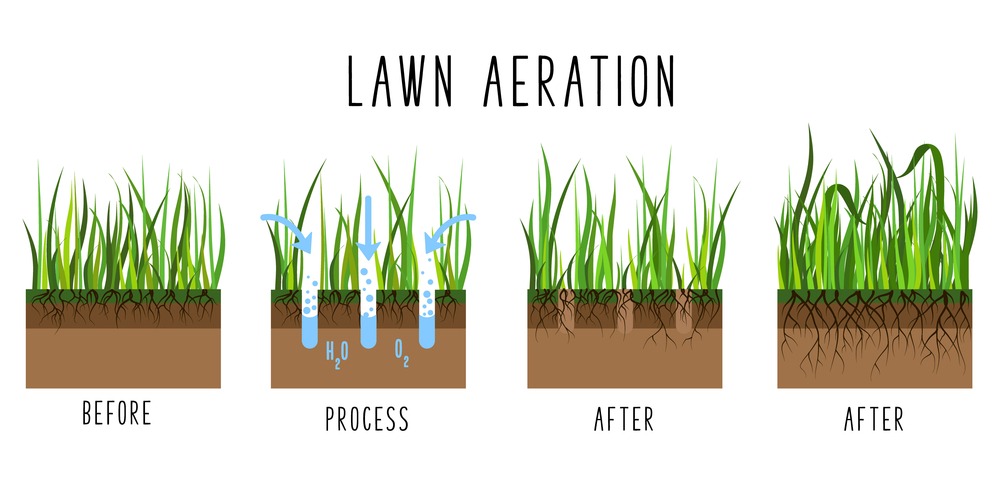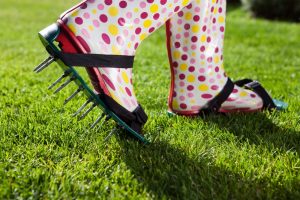
Like most living things, plant roots — including those of turfgrass — need air, water, and nutrients. Unfortunately, traffic on the grass — from feet and vehicle/equipment tires, even from lawnmowers — can compact the soil, squeezing out the spaces between soil particles and preventing the vital movement of air, water, and nutrients down to where the grass needs them. But even a compacted soil-surface layer as thin as 1/4” or 1/2″ can prevent your lawn from growing its best.
So do you know the basics of lawn aeration? Read on for helpful tips to keep your lawn looking its best!
What is Lawn Aeration?
Lawn aeration is the process of puncturing the soil with small holes that aid vital elements, such as air and water, to enter the grassroots. Aeration can help relieve soil compaction, allowing your grass to grow deeper roots and make better use of water and fertilizer. Soil Compaction – Turfgrass in compacted soil (left) grows slowly, lacks vigor, and becomes thin or does not grow at all. Lawn aeration can be done by hand (or foot!) and with machinery.
Why Does a Lawn Need Aeration?
Practically all lawns can benefit from aeration. But if you want a great lawn, lawn aeration is a requirement! Deprived of their basic needs by compacted soil, lawn grasses will struggle in stressful situations, such as heat and low rainfall, and lose their healthy, rich color.
If this continues, grasses gradually thin and eventually die out completely. They wither away for lack of oxygen, water, and nutrients that are available just inches away.
Thus, not only does aerating your lawn allow more nutrients, water, and sunlight to pass through, but it also stimulates the development of your grassroots. This, in turn, helps your grass grow thicker and stronger and stay green longer during a summer dry spell.

Lawn aeration can be as simple as walking around your lawn!
How It Works
Thankfully, correcting a compaction problem is relatively easy with aeration machines (also called aerators or aerifiers). Aerators push tines (spikes) down into the ground to open up the soil. Some aerators have solid tines, while others have hollow tines that pull up plugs of soil (called cores). The best aerators for lawns are those with hollow tines since the solid tines can actually further compact the soil around them.
Some aerators are equipped with a bin or bag to collect the removed cores of soil as the machine moves. Other people just allow the cores to remain on the surface and then break down over time. Regardless, after aerating your lawn, it’s a great time to topdress (spread a thin layer) with either sand (for clay soils) or compost (for sandy soils) over the lawn and then brush the material into the core holes.
Lawn Aeration Frequency
In general, a lawn should be aerified each year at a time when the grass is actively growing but still has time to recuperate before its dormancy period. For warm-season grasses (like bermudagrass and zoysiagrass), that’s any time in summer.
Before aerating, make sure the soil is somewhat moist but not soggy. Aerification machines vary in size — some are powered walk-behinds, while others are more like ride-on lawnmowers or even as large as a tractor.
Although the smaller aerators are less expensive than the large ones used by sports turf managers and golf course superintendents, even the “lawn size” ones can be pricey. Instead, you can often find them available for rent at many home-improvement stores and lawn/garden centers. Or you can contract with a local landscaping or lawn-care service to perform the work for you. Either way, your lawn will “repay” you after aeration by growing more beautifully!
Looking for New Turf?
Looking for the best sod in your area? The Turfgrass Group has you covered! We can connect you with a local grower to help you order and install beautiful new sod to get your lawn back on track.